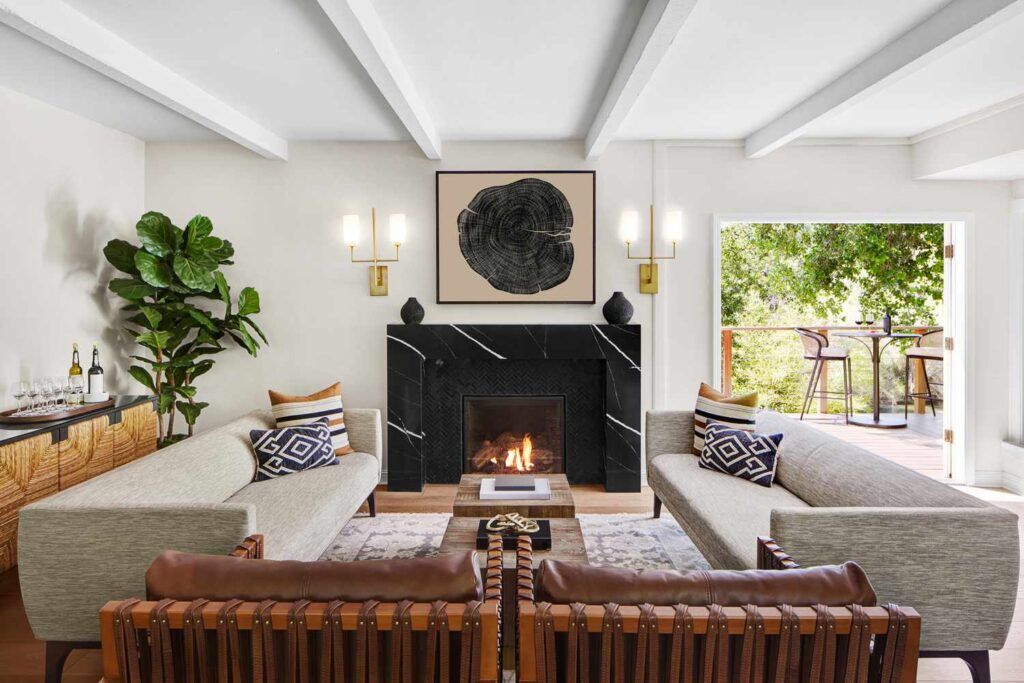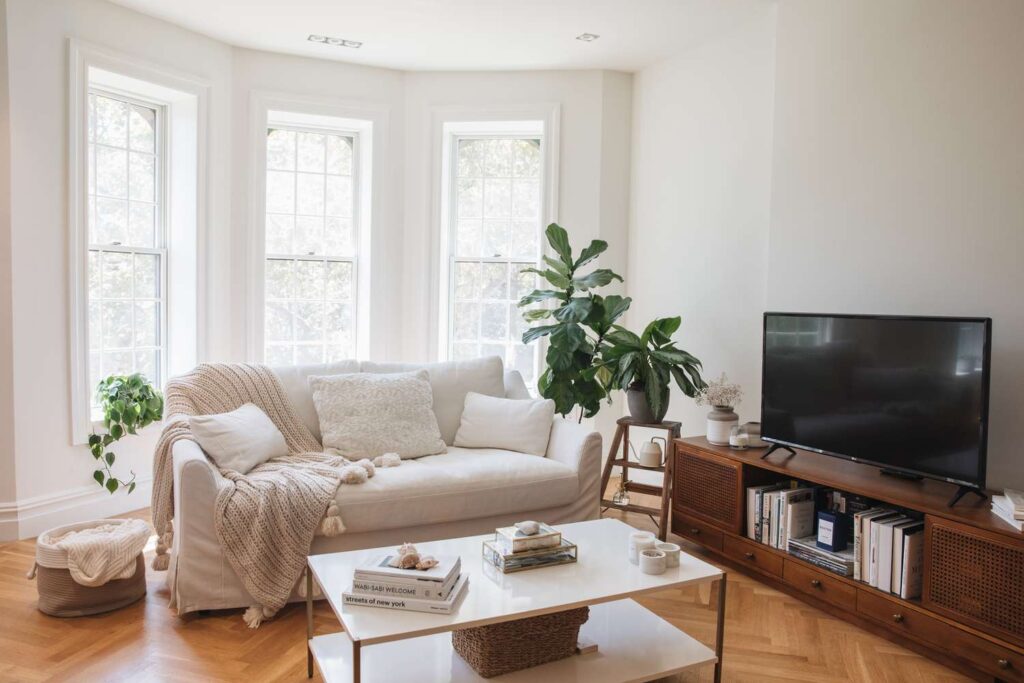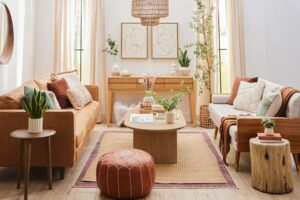How to Choose the Right 3-Seater Sofa to Fit Your Living Room Layout
How Can You Accurately Measure Your Living Room for a 3-Seater Sofa?
Accurate measuring of your living room dimensions prevents costly mistakes when selecting a 3-seater sofa. Start by measuring the room’s width, length, and ceiling height using a tape measure, recording each measurement in centimetres for precision.
3 seater sofas seat height deserves special attention when space planning. The ideal seat height ranges from 43-48cm, which should align with or sit slightly higher than your coffee table. This relationship ensures comfortable reach for drinks and remote controls whilst maintaining proper ergonomic support when sitting and standing.
Essential measurements include:
- Room dimensions: Width, length, and height to determine available floor and vertical space
- Doorways and hallways: Measure the narrowest points, including door frames and stairwell widths, to ensure delivery access
- Sofa parameters: Width (typically 180-220cm for 3-seaters), depth (80-100cm from front to back), and overall height (80-95cm)
Leave at least 45-60cm of clearance around the sofa for comfortable movement and visual balance within your living space.
What Should They Consider About Their Room Layout and Usage?
Living room layout determines how effectively a 3-seater sofa serves daily needs. Identifying whether the space functions primarily for formal entertaining, casual TV watching, or family gatherings shapes every placement decision.

Sofa placement options include positioning against a wall to maximise floor space, floating it in the centre to create distinct zones, or arranging it as part of a sectional configuration. Each approach affects traffic flow and room functionality differently.
Maintaining 45-90 cm of breathing space around the sofa prevents a cramped feeling whilst allowing easy movement. This clearance applies between the sofa and coffee tables, side tables, and other seating pieces.
Coordinating with existing furniture creates visual harmony:
- Rugs should extend beyond the sofa’s front legs
- Coffee tables sit 45 cm from the sofa edge
- Table lamps balance overhead lighting needs
- TV units align with seated eye level
Sectionals suit expansive rooms where L-shaped arrangements define conversation areas, whilst two smaller sofas offer flexibility in compact spaces or rooms with multiple doorways.
How Do They Match Sofa Style and Aesthetics with Their Home Decor?
1. Sofa Style Selection
Choosing the right style for your sofa starts with understanding the existing design of your home. Here’s how different styles work:
- Modern Minimalist: If you have a modern minimalist space, go for sofas with clean lines, low profiles, and sleek shapes.
- Traditional: For traditional rooms, opt for sofas with curved arms, tufted backs, and intricate wooden legs that reflect classic elegance.
2. Home Decor Matching
Matching your home decor goes beyond just furniture shapes; it also involves selecting the right materials. Here’s a breakdown:
- Fabric Sofas: Look for diverse textures in fabric sofas—linen weaves are great for coastal themes, while structured twills suit contemporary settings.
- Leather Types: Consider different types of leather—full-grain options develop character over time, while bonded leather is ideal for budget-conscious buyers.
- Luxury Touches: Introduce tactile luxury with velvet and chenille in formal lounges, or opt for practical durability in high-traffic homes with microfiber.
3. Colour Coordination
Creating visual harmony within your space relies on effective colour coordination:
- Neutral Shades: Use neutral shades like grey, beige, and cream as versatile foundations that can adapt to evolving decor.
- Bold Colours: Incorporate bold colours such as navy, emerald, or terracotta as statement pieces that anchor room schemes.
- Pattern Considerations: Balance busy upholstery patterns with solid-coloured accessories or vice versa for a cohesive look.
4. Transitional Styles
Transitional styles combine elements of both traditional comfort and modern simplicity. This flexibility is perfect for homeowners who want to blend different design periods seamlessly.
What Comfort Features Should They Look For in a 3-Seater Sofa?
Sofa comfort depends primarily on cushion depth and firmness matching your lifestyle needs. Deeper seats (60-70cm) encourage lounging and relaxation, whilst shallower seats (50-55cm) promote upright posture for formal conversations or dining-adjacent seating.
Understanding Cushion Firmness
Cushion firmness ranges from plush to firm, each serving different preferences:
- Plush cushions: sink under body weight, creating a cosy nest-like feel
- Medium-firm options: balance support with softness for versatile use
- Firm cushions: maintain their shape and provide superior back support
Choosing Between Feather and Foam Cushions
When it comes to cushion materials, my experience with the Cozey couch has taught me a lot. Feather-filled cushions offer luxurious softness but require regular fluffing to maintain appearance and even distribution. They compress over time, creating a lived-in aesthetic some find charming whilst others consider untidy.
On the other hand, what I’ve learned about couches is that foam cushions deliver consistent support with minimal maintenance, retaining their shape through daily use. High-density foam resists sagging but may feel initially stiff compared to feather alternatives.
The Importance of Removable Cushions
In my quest for the comfiest outdoor cushions, I found that removable cushions simplify cleaning routines, particularly valuable for households managing spills or pet hair. Fixed cushions create sleeker lines but limit deep-cleaning options, affecting long-term hygiene and freshness.
How Can They Ensure Durability and Ease of Maintenance?
Durable sofas start with sturdy hardwood frames—kiln-dried oak, beech, or eucalyptus—that can handle daily use from families and regular visitors. Engineered wood or metal frames are budget-friendly options but may not last as long.
Leather care, which requires minimal effort, involves wiping spills immediately and conditioning every 6-12 months to keep surfaces supple. Scratches from pets remain visible, though they develop character over time. On the other hand, fabric maintenance demands more attention—vacuuming weekly prevents dust accumulation, whilst professional cleaning every 12-18 months removes embedded dirt. To ease this burden, you could explore some furniture care tips that provide valuable insights on maintaining different types of sofas.
Slipcovers transform maintenance routines for households with pets or toddlers. Machine-washable covers protect the underlying upholstery from stains, fur, and spills, extending the sofa’s lifespan considerably.
Simple habits preserve sofa quality:
- Rotate cushions monthly to distribute wear evenly
- Keep sofas away from direct sunlight to prevent fading
- Use arm covers in high-traffic areas
- Address stains immediately with appropriate cleaning solutions
- Tighten loose screws and bolts annually
Performance fabrics treated with stain-resistant coatings offer the aesthetic appeal of traditional textiles with enhanced durability, making them ideal for busy households. These fabrics are especially beneficial in homes where wear and tear is commonplace due to their robust nature. For those who prefer fabric sofas, understanding the care and maintenance required can significantly enhance their longevity.
What Additional Features Could Enhance Their Sofa Experience?
Ottoman options transform a standard 3-seater into a versatile lounging space. Pairing the sofa with a matching ottoman provides extra seating, a footrest for relaxation, or even a makeshift coffee table with a tray on top. Chaise lounges attached to one end create an L-shaped configuration perfect for stretching out during film nights.
Sofa beds serve dual purposes in homes where space is precious. Pull-out mechanisms convert the seating area into a sleeping surface for overnight guests, eliminating the need for a separate guest bedroom. Modern designs ensure the mattress quality rivals traditional beds whilst maintaining daytime comfort.

Contemporary sofa features cater to tech-savvy households and comfort seekers alike. Reclining sofas with manual levers or power buttons allow customised positioning for reading or napping. Built-in storage compartments hide blankets and remote controls, whilst integrated USB ports keep devices charged within arm’s reach. Cup holders prevent spills during movie marathons, making these additions particularly valuable for families who prioritise both functionality and convenience in their living spaces.
How Should They Set a Budget and Evaluate Quality Assurance?
Setting a realistic budget first prevents overspending and narrows down options to manageable choices. Sofa budget planning directly impacts the quality of materials, construction durability, and comfort features available—higher investments typically yield better craftsmanship and longer-lasting pieces.
Research becomes essential when evaluating quality assurance. Reading customer reviews on reputable brands reveals real-world experiences with durability, comfort retention, and after-sales service. Look for consistent feedback patterns rather than isolated complaints.
Warranty coverage protects your investment. Quality manufacturers typically offer:
- Frame warranties (10-25 years for hardwood frames)
- Cushion warranties (2-5 years minimum)
- Fabric protection plans
- Clear return policies with reasonable timeframes
Check restocking fees before purchasing, as some retailers charge 15-25% for returns.
Safety and quality standards matter significantly. Verify that sofas meet fire safety regulations and use certified materials free from harmful chemicals. Reputable brands display compliance certifications prominently, ensuring your 3-seater sofa meets industry benchmarks whilst fitting your living room layout perfectly.
Related : Where to Find Stylish and Affordable Corner Sofas Across Sydney

